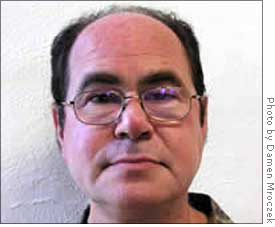| << Front page | News | April 30, 2004 |
Off the Cuff: Roger Copeland
 |
||
| Roger Copeland | ||
Professor of Theater and Dance Roger Copeland is most well known at Oberlin for his seminal class, “The History of the Western Theater.” He is currently working on a film and has just recently published a book titled Merce Cunningham and the Modernization of Modern Dance.
I hear you’ve been working on a film?
It’s called The Unrecovered. The title refers not only to the “unrecovered” bodies at ground zero, but also to the state of the culture-at-large. The film is set in that very strange period of time between Sept. 11, 2001 and Halloween of that year. It sets out to examine the effect of terror on the average mind, the way a state of heightened anxiety or alertness can cause the “average” person to make the sort of “imaginative connections” that are normally made only by two distinct categories of people: artists and conspiracy theorists. It’s an attempt to paint a portrait of the way in which irony, empathy and paranoia played off of one another in the immediate aftermath of 9/11.
Where did you get the idea for The Unrecovered?
The initial impetus for the film was an unfortunate comment about 9/11 that the German composer Karlhein Stockhausen made a mere five days after the attacks. He told an interviewer that the events in New York and Washington amounted to “the greatest work of art in Western history.” Many artists, even if they didn’t dare admit it, found themselves envying the sheer power, sensory impact and global reach of what the terrorists accomplished on Sept. 11. One of the most extraordinary things about the attacks is that they were not just unexpected, but unimagined. Perhaps unimaginable. A true leap of human imagination, no matter how perverse. So I began to conceive of a character, a young American composer, who’s anguishing over Stockhausen’s comments, and the film developed from there.
Do you have any plans to release the film theatrically?
The finished film promises to be so long and so eccentric that it’s difficult for me to imagine any sort of conventional theatrical release. But I hope it will be screened at film festivals and perhaps in some form on cable television. I’ve already started screening rough cuts of the film for university audiences both in this country and in Europe.
You’ve also recently published a book on the dancer Merce Cunningham. How did you first come into contact with him, and what made him stand out to you?
I first saw the Cunningham company perform in May of ’68 and I was immediately hooked. There was a kind of bodily intelligence on display that I’d never seen before in a modern dance company. The choreography was so lean and clean and precise, none of the dramatized angst that I’d come to associate with earlier traditions of modern dance, most notably with the work of Martha Graham.
Your book is subtitled The Modernization of Modern Dance. Could you explain what you’re getting at?
The basic argument of the book is that Cunningham more radically than any other choreographer in the second half of the 20th century redefined what we think of as “modern dance.” He did this by rejecting the basic impulse that animated so much of the long tradition of early modern dance stretching all the way from Isadora Duncan through Martha Graham: the desire to seek inspiration from so-called “primitive” sources such as the movement motifs and mythic narratives of ancient Greece. The irony is that before Cunningham, what we call modern dance actually rejected “modernity.” Cunningham, by contrast, choreographs dances that celebrate the speed, fragmentation and simultaneity of stimuli peculiar to contemporary urban life.
You went on a European book tour for the work. When you were abroad, were you thinking about 9/11 and its effect on the international community?
It was hard not to. The Madrid subway bombings took place just a week or so before I arrived in Paris, and Jacques Chirac had recently proposed banning Muslim head scarves in French public schools. So the French, even though they were wise enough not to support the U.S. in Iraq, still seemed a very likely target for Al Queda. One of the programs I did in Paris was at the American Embassy and the security cordons were like something out of a James Bond film.
Do you have any new projects on the horizon?
What I’m working on now is a sequel that deals with Cunningham’s influence on a wide variety of performance practices, everything from post-modern dance to the relationship of sound and image in the work of Robert Wilson.
About us
Subscriptions
Advertising
|